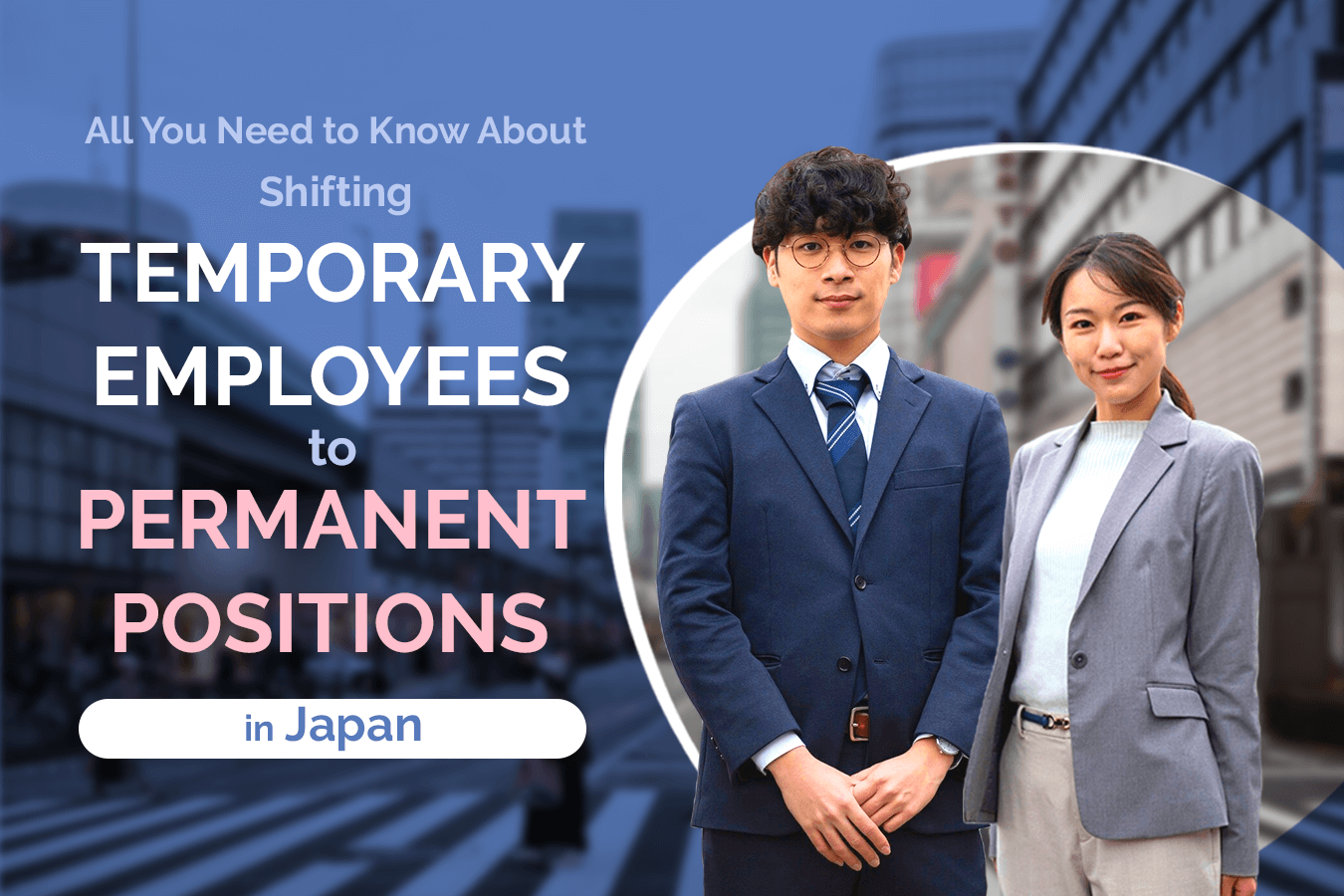All You Need to Know About Shifting Temporary Employees to Permanent Positions in Japan
September 27, 2024

Ever had a stellar temp come to work at your company and thought, “I wish we could make them a permanent member of our team”?
The shift makes logical sense. After all, if you want someone permanent to fill a position, why go through the time consuming and costly recruitment process when the right person is sitting at the desk across from you?
Unfortunately, you then look at the contract you have with the temping agency. The procedures involved in shifting a temp worker to a permanent status are complicated and the fees are difficult to seem costly. The decision becomes more complicated.
This article provides a step-by-step guide to the process and fees involved in moving temporary employees into permanent positions, as well as a detailed explanation of both the benefits and drawbacks.
Table of Contents
1. Benefits and Drawbacks of Moving Temporary Workers to Permanent Position
While there are many benefits to shifting temporary employees to permanent positions, there are also some drawbacks to consider. Here we focus on the benefits and explore the potential disadvantages.
1-1. Benefits
- Securing Top Talent
The greatest advantage of converting a temporary employee to a permanent position is the ability to retain a highly-skilled individual who is already well-versed in your business operations and culture. Since you can assess the employee’s suitability for a permanent role based on their performance as a temporary worker, you can avoid mismatches post-hire. Additionally, as a permanent employee, they are likely to be more motivated, which can lead to further growth. - Reduced Recruitment Costs
When hiring new permanent employees, companies typically incur expenses related to job advertisements, as well as the process of vetting, interviewing, and recruitment administration. Add to this the cost of orientation and training and the costs soon mount. By making a temporary worker into a permanent employee, you can significantly reduce or eliminate these costs. Furthermore, because the staff member is already familiar with the job and company, they can start work immediately without disruption to business. - Expanding Job Scope
Temporary employees are generally limited to tasks outlined in their contracts. However, as permanent employees, they can be entrusted with a broader range of responsibilities. This flexibility allows for more effective utilization of internal resources, contributing to project progress and operational efficiency. Additionally, as permanent employees, they can be transferred to other departments or participate in new projects, providing them with skill and knowledge growth opportunities. - No Employment Period Restrictions
Under Japan’s Worker Dispatch Law, it is not possible to continuously renew a temporary workers contract. The maximum period a temporary employee can work in a particular position is three years. After that, they either have to be hired permanently or replaced by a new temporary worker. If a temp worker becomes a permanent employee, however, these time restrictions obviously no longer apply. The company is able to achieve business continuity and can focus on long-term projects without the need to worry about staffing changes. This is particularly beneficial for employers taking on people with specialized knowledge or skills who can contribute to the company from a long-term perspective. - Improved Motivation and Productivity
Companies that actively engage in shifting temporary staff into permanent positions tend to have higher employee engagement and productivity levels across their organization. This is because it shows that the organization cares about the talent it has and is actively trying to keep workers it recognizes as skilled and hardworking. For temps who become permanent employees, they find greater work stability, since they are no longer shifting from company to company for different projects. It can give them a clearer image of their long-term career path and make it easier to work toward a particular career goal. All this creates a positive atmosphere which helps to motivate people to do their best. - Enhanced Corporate Image
Finally, this practice also sends a strong brand message to prospective recruits and customers. A company that cares about its workforce also cares about its clients, because the best people provide the best services. This can help attract top talent to the organization as well as new clients, boosting its business opportunities.
1-2. Drawbacks
- Increased Labor Administration Costs
Although it is possible to cut recruiting and training costs by making temporary workers permanent employees, there will inevitably be an increase in costs related to salaries, benefits, and labor management. Responsibilities previously handled by the staffing agency will now fall on the employer, adding to the company’s administrative burden. These include costs related to social insurance, pensions, and leave benefits. Comprehensive cost management is essential. Moreover, managing working hours and employee training becomes more complex, requiring careful planning. - Difficulty Adjusting Staffing Levels
Temporary employees can have their contracts terminated upon contract expiration, but permanent employees are legally protected against dismissal without just cause. This means that making employment adjustments in response to changes in demand and circumstances is more challenging. To terminate permanent employees, the company must have substantial reasons, and the process must comply with labor laws which make staffing adjustments very difficult. - Complexity in Labor Management
When a temporary employee shifts to a permanent position, they will handle a wider range of responsibilities compared to when they were a temporary worker. This necessitates managing working hours, payroll, and benefits, among other administrative tasks. Although the increase in labor management may not be dramatic, the impact can vary depending on the company’s size and existing management system, so it’s important to be aware of this beforehand.
2. Steps for Permanent Conversion
Next, let’s look at the key steps involved in giving a temporary employee a permanent position.
- Review the Contract with the Staffing Agency
The contract often includes specific conditions and fees related to shifting a temporary employee to a permanent position. Understanding these terms will provide a solid foundation for a smooth transition. For example, in the case of a temp-to-perm arrangement (where the company takes on a temporary worker with a mind to hiring them permanently in the future), the contract usually stipulates that the temporary employee may be hired permanently after a certain period, along with any associated fees or extension options. - Discuss the Shift with the Staffing Agency
This is especially important if you wish to make the conversion during the contract period or if the temporary employee is under an indefinite-term contract with the agency. Maintaining good communication with the agency and clarifying the conditions and procedures during this stage is crucial. In addition to the contract terms, it’s also important to discuss any concerns or requests the temporary employee may have regarding the employment transfer process with the agency. - Make Sure the Employee UnderstandsTheir New Work Conditions
After coordinating with the staffing agency, the next step is to present the permanent employment terms to the temporary employee. This includes explaining all conditions such as salary, working hours, job responsibilities, and benefits in detail. If the move to a permanent position involves different duties or responsibilities, it’s important to explain these changes clearly and ensure they are understood. Additionally, according to labor laws, employment terms must be provided in writing, so it’s essential to document the agreed-upon conditions to ensure mutual understanding. - Sign the Employment Contract
Once the conditions are agreed upon, it is time to finalize the employment contract, formalizing the temporary employee’s transition to a permanent role within the company. Careful attention should be paid to drafting the contract to ensure that no critical terms are omitted. It’s particularly important to include key details such as the probationary period, payment terms, and conditions regarding termination. Furthermore, onboarding procedures and any necessary training should be prepared in order to facilitate a smooth transition to permanent employment.
3. Points of Caution, Costs and Employment Grants
3-1. Referral Fees
When shifting a temporary employee to a permanent position, a referral fee may be payable to the staffing agency. The standard referral fee is typically 15% to 30% of the employee’s annual salary, but this rate may vary depending on the length of the temporary assignment and the contract terms. For example, in a temp-to-perm arrangement, longer temporary periods generally result in lower fees. It is possible to off-set these costs using Career Advancement Grants, which will be discussed shortly.
3-2. Terminate the Temporary Contract before Shifting Employment Status
The process of shifting a temporary employee to a permanent position, should only be initiated after the temporary contract has been terminated. As mentioned earlier, communication with the agency is vital. It is important to remember that directly hiring a temporary employee during their contract period without consulting or negotiating with the temp agency can lead to disputes and can result in being charged penalties for breach of contract. It can also make it more difficult to use temping services in the future, so make sure you talk to the agency and comply with the terms that were agreed to initially. Furthermore, from an administrative standpoint, coordinating with the staffing agency and the worker to time the end of the contract with the shift in the worker’s employment status makes the process run much more smoothly. It also helps to reassure the worker that they have made the right decision.
4. Utilizing Career Advancement Grants
Companies can reduce the financial burden of shifting temporary employees to permanent positions using Career Advancement Grants. These grants are provided to companies that move non-regular employees (temps, part-timers, etc.) to permanent employment positions. Under the latest of iteration the grant program (November 29, 2023), small and medium-sized enterprises (SMEs) receive ¥800,000 for each employee moved from a temporary to a permanent position, while large companies receive ¥600,000. Additionally, companies using this system for the first time are eligible for an additional ¥200,000, while a company that establishes systems for location-limited, duty-limited, or part-time regular employees, can see the additional amount increase from ¥200,000 to ¥400,000.
To utilize these grants, certain conditions must be met. For instance, the temporary worker must have at least six months of employment history with the company, and the worker must continue working for the company for a specified period after being given a permanent position. The Ministry of Health, Labour, and Welfare’s official website provides detailed information on these requirements, and it is a good idea to review them thoroughly before preparing your grant application.
Reference: For more information, please visit the Ministry of Health, Labour, and Welfare’s page on Career Advancement Grants (Japanese website).
5. Conclusion
Shifting temporary workers’ employment status may not be suitable for all situations, since temporary contracts offer unique benefits, such as the ability to focus resources during specific periods or on particular projects.
However, if you are thinking long term, it is an attractive option with the benefits of securing good staff quickly and efficiently, expanding the scope of a talented worker’s job, and boosting the company’s internal and external branding, often outweighing the concerns.
If you are looking for IT engineering talent, contact ISF NET. We are one of Japan’s largest IT service providers specializing in IT infrastructure staffing services and IT infrastructure solutions. Contact us now for more details.
Explore our IT Staffing Solutions and learn how we can provide you with the right talent to optimize your IT infrastructure.
Return to the page of Managed Service of the bilingual help desk and onsite | ISF NET, INC.
